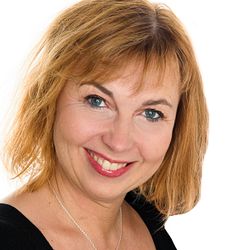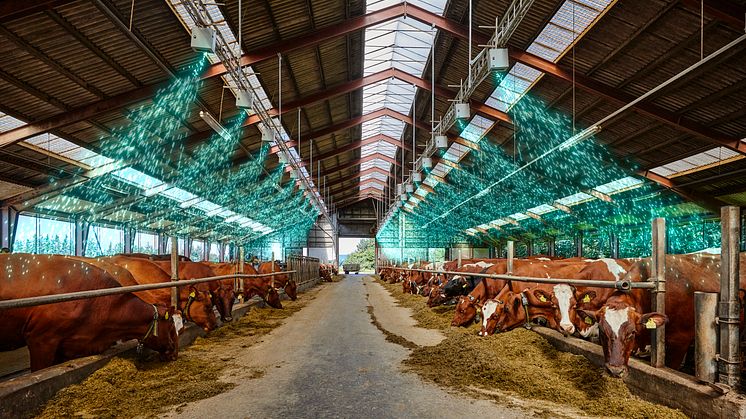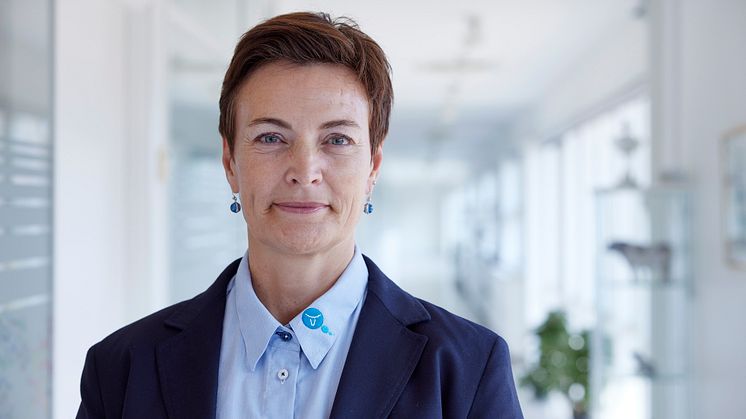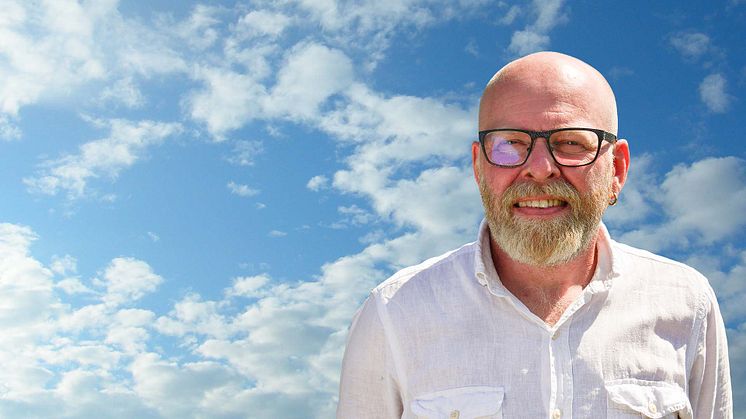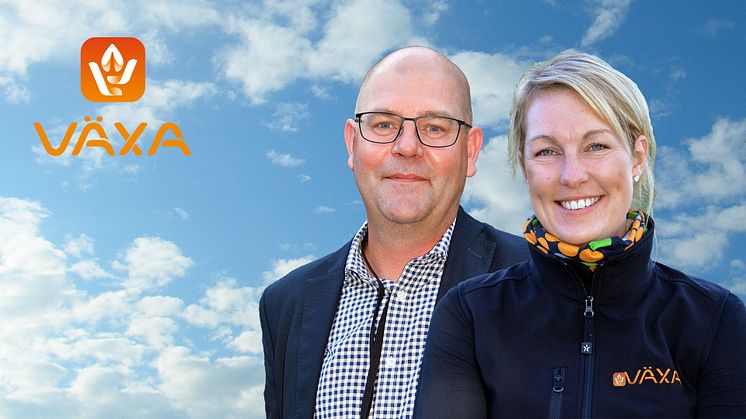
Pressmeddelande -
VikingGenetics satsar på CFIT, fodereffektivitet för lägre kostnader och metanutsläpp
Under något år har VikíngGenetics arbetat med en ny teknologi, CFIT, som minskar nötkreaturs foderbehov och därmed minskar utsläppen av växthusgaser. Nu ökar VikingGenetics satsningen med fler testgårdar, snart även i Sverige.
Cattle Feed Intake System (CFIT)-projektet, samlar data för att beräkna det som kallas Nordic Saved Feed Index. Allt fler CFIT-anläggningar tas i bruk och data kommer att samlas in från mer än 30 000 kor. Detta gör att det dagligen kommer att göras mer än 1 300 000 registringar av kors foderintag per dag innan 2025.
Datan som samlas i Saved Feed Index används i avelsarbetet och kommer att bli en del av VikingGenetics avelsvärde NTM. CFIT-anläggningarnas data kommer även att kunna användas för att vägleda lantbrukarna i vilka fodergivor som har låg kostnad och samtidigt minskar utsläppen av växthusgaser, som metan.
- Inom en nära framtid kommer vi att ha ett par försöksgårdar för CFIT i Sverige. De är en viktig satsning för säkra att förhållandena på våra hemmamarknader tas tillvara inom CFIT-teknologin. Genom anläggningarna i Sverige och Finland är vår målsättning att få fler registreringar för den röda rasen. Den nya teknologin är intressant för avelsarbetet i Sverige och globalt, och är en viktigt del i en ännu mer hållbar mjölk- och nötköttsproduktion, säger Gustav Jahn, Avdelningschef Avel, Växa.
Nya siffror från en undersökning som använder data från CFIT visar att genetisk selektion kan bidra till ökad fodereffektivitet och 2050 kan reduktionen vara hela 3,2 millioner kg CO2eq. om året, vilket är ca. 20 procent lägre totala utsläpp från VikingGenetics hemmamarknader i Danmark, Sverige och Finland). Och siffrorna ser bättre och bättre ut för varje år.¨
Pressrelease in English from VikingGenetics
Accelerating investment for improved feed efficiency technology
VikingGenetics is stepping up its commitment by accelerating investment in the Nordic Saved Feed Index, to include registrations from more than 30,000 cows. Resulting in more than 1,300,000+ daily intake records by 2025.
As part of its commitment to innovative breeding and future-friendly farming, VikingGenetics’ Board of Directors has decided to speed up investment in the Cattle Feed Intake System (CFIT) project that collects data for calculating the Saved Feed Index. The goal is to have feed intake data for 30,000 cows by 2025 for its three major dairy breeds – Holstein, Jersey, and Red Dairy Cattle. VikingGenetics are the only company in the world to have a Saved Feed Index on the Jerseys and the Red Dairy breed.
This decision aims to continue growing the collaboration with farmers in VikingGenetics' home markets (Denmark, Finland, and Sweden) and globally, by giving them more opportunities to access highly reliable feed-efficiency data. The data can help farmers make better-informed decisions that increase their herds’ feed efficiency and cut costs, reduce emissions, and make their lives easier.
Per-Johan Svensson, Chairman of the Board for VikingGenetics, highlights the benefits saved feed offers to farmers, stating: “VikingGenetics wants to maintain their position among the world leaders within selection for improved energy efficiency and reduced climate impact. Therefore, this is the right time to promote investment in the CFIT System and get more data from more cows. This will benefit all farmers using VikingGenetics and the planet.”
Research into greenhouse gases indicates that, on average, 6% of the energy that a cow eats is spent on producing methane. However, this varies from 2-12% depending on how efficient the cow is in converting feed into milk.
What are CFIT and the Saved Feed Index?
The CFIT System is a patented, artificial intelligence-based solution that uses 3D cameras and deep learning to monitor the feed intake, 24/7, over each cow’s lifetime at a mass scale in the cow's natural environment. The system is currently implemented across 19 partner commercial farms, monitoring over 7,000 cows – with more installations taking place between 2023 and 2024 – adding up to 30,000 cows.
The individual cow´s feed intake data is collected throughout lactation from commercial herds – without disturbing the daily routines and cows’ natural behaviour.
The collected data is used to inform and supplement the Saved Feed Index which, since 2019, provides a genetic measure of each bull’s ability to transmit ‘metabolic efficiency’ to his progeny, and other efficiency traits. The index is used by dairy farmers in all countries where VikingGenetics is present, helping them select breeding bulls based on daughter feed efficiency.
Louise Helmer, Chief Executive Officer (CEO) at VikingGenetics, adds to this, saying: “We believe that the Saved Feed Index based on registrations on a minimum of 30,000 dairy cows by 2025 will benefit all farmers using our genetics. With this investment acceleration, we will be able to faster put more future-friendly value into each dose of semen we produce.”
More data, more feed-efficient cows
“At VikingGenetics, we have a clear strategy to support and invest in R&D to maximize benefits for farmers, supported by our partnerships with various research and academic organizations,” says Søren Borchersen, Chief Research and Development Officer (CRADO) for VikingGenetics. “Through this acceleration, scientists from VikingGenetics and Aarhus University in Denmark will have access to funding sooner than originally planned, pushing forward CFIT installations in more farms within our home countries.”
This way, VikingGenetics and its research partners will be able to collect data more efficiently, and faster, from a larger number of herds with different production systems and management levels. This will result in more extensive and reliable data for VikingHolstein, VikingJersey, and VikingRed, benefitting the collaboration between farmers and researchers toward breeding high-producing, feed-efficient and low-emission cows.
Mr. Borchersen further explains the importance of having access to more data: “The CFIT system is the right system to make large-scale direct measurements of feed intake and body weight on individual cows in commercial herds. More data is needed faster to ensure that we can fully benefit from the CFIT system in our evaluations. This way, we will also be able to address other key issues for future dairy production, with a focus on healthy and efficient cows.”
Breeding the cows of the future
With CFIT and the Saved Feed Index, dairy farmers can breed for improved feed efficiency – without compromising on the production, health and reproductive performance of cows. In combination with genomic testing, farmers get a highly detailed overview of each cow’s genetic potential for all profit-driving traits. This way, they can identify their best-performing and most feed-efficient cows and use them to selectively breed the climate-friendly cows of the future.
New figures from a study using the CFIT-collected data estimate that, by 2050, the reduction of greenhouse gases through genetic selection for improved feed efficiency will lead to a reduction of 3.2 million kg CO2eq. per year – approx. 20% less total cattle emissionsin VikingGenetics home markets by 2050 – with figures likely to improve on a yearly basis, as more data becomes available.
For further information:
CEO Louise Helmer
Mobile +45 2053 2905
lohel@vikinggenetics.com
CRADO Søren Borchersen
Mobile +45 2360 0763
sobor@vikinggenetics.com
For any additional requests, please contact:
Content Writer, Tomás De La Rosa at tomro@vikinggenetics.com
Photo:
Photos can be downloaded here; https://bulldam.canto.global/v/VikingGeneticsphotogallery/landing?viewIndex=1
Additional quotes:
“We believe CFIT has the scope to transform dairy cow management as well as cattle breeding, cut the use of feed used worldwide and achieve commensurate reductions in greenhouse gas emissions.” – Søren Borchersen
“Having individual feed intake records on commercial dairy farms is a game-changer in modern dairy cattle management. With CFIT, both farmers and researchers have access to a lot of new data on cow behaviour, feeding and health. The use of digitalization in practice generates a lot of new and better ways to manage dairy production.” – Søren Borchersen
Relaterade länkar
Ämnen
Kategorier
Växa ägs av lantbrukare och är landets största husdjursförening med drygt 6 000 medlemmar som också är våra kunder. Vi är ett modernt rikstäckande rådgivnings- och serviceföretag och vänder oss främst till mjölk- och köttföretagare.

